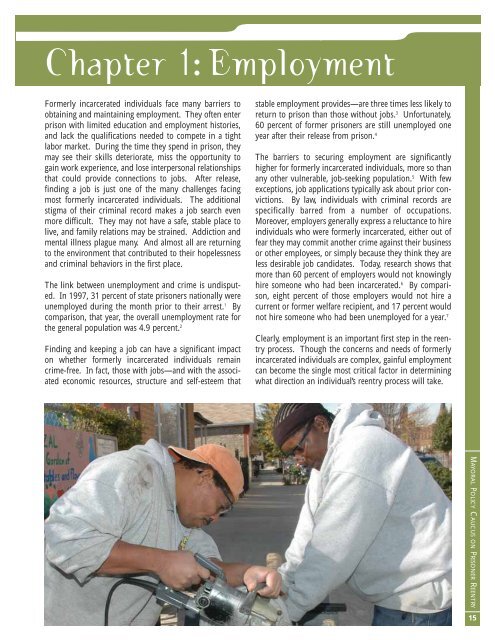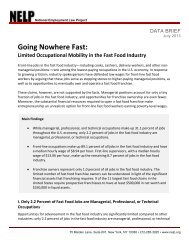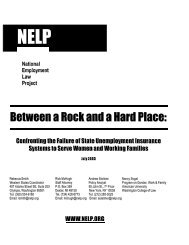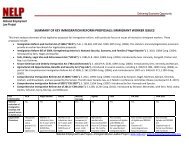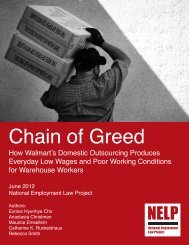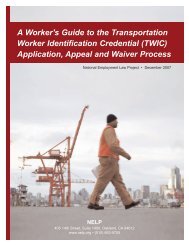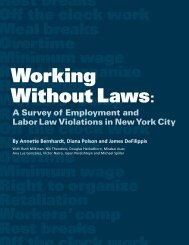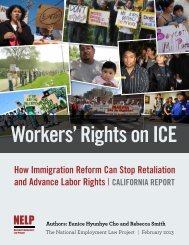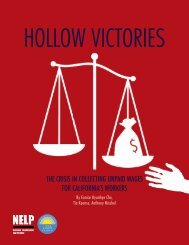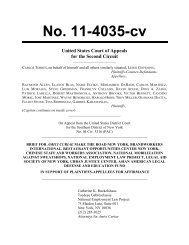Rebuilding Lives. Strengthening Communities.
Rebuilding Lives. Strengthening Communities.
Rebuilding Lives. Strengthening Communities.
You also want an ePaper? Increase the reach of your titles
YUMPU automatically turns print PDFs into web optimized ePapers that Google loves.
Chapter 1: Employment<br />
Formerly incarcerated individuals face many barriers to<br />
obtaining and maintaining employment. They often enter<br />
prison with limited education and employment histories,<br />
and lack the qualifications needed to compete in a tight<br />
labor market. During the time they spend in prison, they<br />
may see their skills deteriorate, miss the opportunity to<br />
gain work experience, and lose interpersonal relationships<br />
that could provide connections to jobs. After release,<br />
finding a job is just one of the many challenges facing<br />
most formerly incarcerated individuals. The additional<br />
stigma of their criminal record makes a job search even<br />
more difficult. They may not have a safe, stable place to<br />
live, and family relations may be strained. Addiction and<br />
mental illness plague many. And almost all are returning<br />
to the environment that contributed to their hopelessness<br />
and criminal behaviors in the first place.<br />
The link between unemployment and crime is undisputed.<br />
In 1997, 31 percent of state prisoners nationally were<br />
unemployed during the month prior to their arrest. 1 By<br />
comparison, that year, the overall unemployment rate for<br />
the general population was 4.9 percent. 2<br />
Finding and keeping a job can have a significant impact<br />
on whether formerly incarcerated individuals remain<br />
crime-free. In fact, those with jobs—and with the associated<br />
economic resources, structure and self-esteem that<br />
stable employment provides—are three times less likely to<br />
return to prison than those without jobs. 3 Unfortunately,<br />
60 percent of former prisoners are still unemployed one<br />
year after their release from prison. 4<br />
The barriers to securing employment are significantly<br />
higher for formerly incarcerated individuals, more so than<br />
any other vulnerable, job-seeking population. 5 With few<br />
exceptions, job applications typically ask about prior convictions.<br />
By law, individuals with criminal records are<br />
specifically barred from a number of occupations.<br />
Moreover, employers generally express a reluctance to hire<br />
individuals who were formerly incarcerated, either out of<br />
fear they may commit another crime against their business<br />
or other employees, or simply because they think they are<br />
less desirable job candidates. Today, research shows that<br />
more than 60 percent of employers would not knowingly<br />
hire someone who had been incarcerated. 6 By comparison,<br />
eight percent of those employers would not hire a<br />
current or former welfare recipient, and 17 percent would<br />
not hire someone who had been unemployed for a year. 7<br />
Clearly, employment is an important first step in the reentry<br />
process. Though the concerns and needs of formerly<br />
incarcerated individuals are complex, gainful employment<br />
can become the single most critical factor in determining<br />
what direction an individual’s reentry process will take.<br />
MAYORAL POLICY CAUCUS ON PRISONER REENTRY<br />
15


